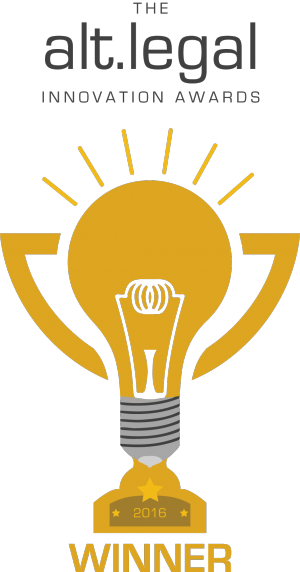ATL alt.legal Innovation Awards Winner: 5 Questions With Alma Asay
Allegory is a cloud-based "smart" software that connects all the pieces of a litigation and automates many tasks.
 Above The Law launched the alt.legal ATL Innovation Awards last fall to recognize emerging companies that are addressing legal technology. Fifteen finalists pitched their startups at the University of Pennsylvania Law School. Judges were Joe Borstein (Thomson Reuters and ATL alt.legal columnist), Mary Juetten (CEO and Founder of Traklight), Nicole “Niki” Black (Legal Technology Evangelist at MyCase), and Monica Bay (journalist and ATL columnist).
Above The Law launched the alt.legal ATL Innovation Awards last fall to recognize emerging companies that are addressing legal technology. Fifteen finalists pitched their startups at the University of Pennsylvania Law School. Judges were Joe Borstein (Thomson Reuters and ATL alt.legal columnist), Mary Juetten (CEO and Founder of Traklight), Nicole “Niki” Black (Legal Technology Evangelist at MyCase), and Monica Bay (journalist and ATL columnist).
Following up on the event, ATL has been posing five questions to the winners. Our goal: To show you a quick look at the startups — and the people behind the tech!
Meet Alma Asay, founder and chief executive officer of Allegory Law. She started her career at Gibson, Dunn & Crutcher, where she focused on complex commercial litigation, primarily in the fields of media, entertainment and technology. She earned her J.D. from New York University School of Law in 2005.

Legal AI: 3 Steps Law Firms Should Take Now
Allegory is a cloud-based “smart” software; it connects all the pieces of a litigation and automates tasks to help litigators. In March, the company raised more than $500,000, in a round led by Bob Rowe, former Executive Vice President at Huron Legal.
- What problem does your startup address, and how?
Allegory addresses the problem of litigators not having the information they need at their fingertips—when and how they need it—in order to most effectively represent their clients. Allegory interconnects all the key pieces of a litigation, so information is available to litigation teams—in any way they might need it—on a moment’s notice.
Two examples:
- A lawyer is defending the deposition of a key witness. The other side introduces a document for a purpose that is not immediately clear to the lawyer. Using Allegory, the lawyer can enter the Bates number and immediately see every other instance of the document being used throughout the case, including prior testimony about it and references by each side in correspondence and filings.
Sponsored

Is The Future Of Law Distributed? Lessons From The Tech Adoption Curve

Legal AI: 3 Steps Law Firms Should Take Now

Early Adopters Of Legal AI Gaining Competitive Edge In Marketplace

Early Adopters Of Legal AI Gaining Competitive Edge In Marketplace
- A lawyer is in court, and a witness says something unexpected. The team needs to find all references across the case for the cross-examination, but has only a few minutes. Searching in Allegory, the team can use Google-like context hits across the entire case to quickly review in one place—even from a mobile device—prior testimony, evidence, and other references.
- What is your biggest challenge in attorney adoption of your startup?
The fact that most of our users are attorneys. Lawyers are hesitant to learn new technology because it seems unnecessary when it’s not needed—and there’s not enough time to learn a new way in the moments when it’s needed most. The challenge is to create a mandate from the top to use Allegory, so that the team understands the value. They must make the decision to dive in and learn to use it so they can reap the advantages on the other side.
- Has your startup changed significantly since the very beginning?
In many ways. Most significantly, we changed our model by adding an optional service component. When we show tech to lawyers, one of the most frequent questions we get is, “But how does the information get in there?” The answer: Some organizational work must already be happening. For example, organizing files in folders and tracking insights in a massive Word document—for far less effective retrieval later when team members need information. Instead of fighting to get everyone to input their own information into a new system, we added services to handle input for clients. This enabled us to start taking cases midstream—when litigation teams are feeling the pain of not having effective information management.
Sponsored

The Business Case For AI At Your Law Firm


Navigating Financial Success by Avoiding Common Pitfalls and Maximizing Firm Performance

Alma Asay
- What do you wish you knew five years ago?
I’d like to say that I wish I’d known how hard building a legal tech company would be. But the truth is, I’m probably better off that I didn’t. If I had to pick one thing, I wish I’d known the importance of attending events and getting to know people across informal settings (in other words, networking). This is not something law schools or law firms teach, and so it wasn’t something I valued as a priority when I started. Now, I know better, and I know that my company would be nowhere without all of the people I met in unexpected ways just by getting out and meeting people.
- Name one technology commonly used by lawyers today that will be obsolete in 10 years—and one we will be using in 10 years that they don’t have today.
Is it already too late to say a BlackBerry? If so, using shared drives to manage information will be obsolete in 10 years. For many reasons, from inefficiency to access to security, I don’t see how this practice can continue. We transitioned from file cabinets to shared drives and now it’s time for the next step.
As for what lawyers will be using in 10 years—I think we are on the verge of an “Alexa” for lawyers. With the management of information using software becoming more widespread in legal, we are reaching a stage where it will be possible to start to query that information in more advanced ways. There are, obviously, many issues to work out with respect to security, privilege, etc. But I would be surprised if lawyers weren’t using some kind of voice-activated technologies specific to legal practice in 10 years.
 Monica Bay is a Fellow at CodeX: The Stanford Center for Legal Informatics and a freelance writer for Above The Law and other media. She co-hosts Law Technology Now (Legal Talk Network) and is a member of the California Bar. Monica can frequently be found at Yankee Stadium. Email: monicabay1@gmail.com. Twitter: @MonicaBay.
Monica Bay is a Fellow at CodeX: The Stanford Center for Legal Informatics and a freelance writer for Above The Law and other media. She co-hosts Law Technology Now (Legal Talk Network) and is a member of the California Bar. Monica can frequently be found at Yankee Stadium. Email: monicabay1@gmail.com. Twitter: @MonicaBay.








